Garden watering and irrigation system guide
Garden watering and irrigation system guide
Introduction
Water is an essential nutrient for plants to thrive. So, keeping them well-hydrated is key to having a healthy and luscious garden. There’s plenty of watering equipment available to help you do the job, but which garden watering system is best for your needs?
This guide tells you everything you need to know about garden watering equipment. First, it covers the types available, how they work and what they’re best used for. Then it takes a closer look at automatic garden watering systems and how they work. Finally, it highlights things to consider before buying and answers some frequently asked questions.
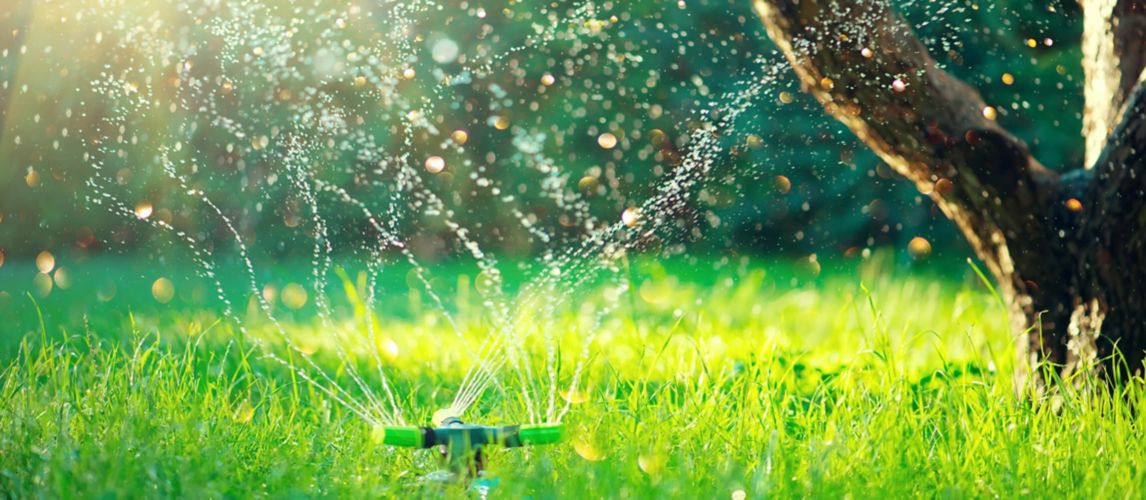
Choosing Watering Tools and Equipment
There are lots of different types of watering tools and equipment available, and what you choose will depend on three main factors:
-
What you’re watering. Different plants will have different watering needs. For example, young seedlings will only need a light sprinkling of water, while a lawn may need a good long soak.
-
How big the task is. If you’re only watering potted plants on a balcony, a watering can will suffice. But if it’s a large garden with lawns and lots of flower beds, a watering system that delivers a high volume of water is best.
-
How big the space is. Consider how water will be transported to all the areas that need water. For example, a small garden may only need a watering can or short hose, while a large garden may need a long hose, a garden sprinkler system or an automatic garden watering system to make the job easier.
Types of Garden Watering Systems
This section looks at all the different types of watering equipment available, how they work and what they’re used for.
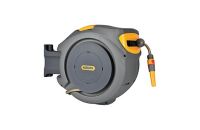
Garden hose types
Garden hoses are probably the most used type of watering equipment in homes. They’re long flexible plastic tubes that connect to a water source to transport high volumes of water wherever you need it.
Hoses are suitable for use in any sized garden. But there are lots of options to consider before choosing the best type of garden hose for your needs:
-
Hose material: All hoses are made from flexible plastic, but their quality is determined by their thickness. A hoses’ thickness is referred to as ‘layers’ or ‘ply’, ranging from 3-ply to 6-ply. The higher the ply, the better quality the hose is, as it determines how well the hose can withstand knots, kinks and bends.
-
Hose length: Hoses typically come in lengths varying from 10m to 50m. Choose a length suitable for the garden you are watering. It will need to comfortably reach all corners of the garden without having too much excess that could get in the way.
- Hose features: Some hoses have additional features. For example, there are braided hoses with added wire mesh that makes them resistant to kinking, twisting, bending or getting crushed. Then spiral hoses stretch out when in use then spring back into a coil. And there are expandable hoses made of webbed material that expands when filled with water and shrinks back for storage. You can also buy weatherproof hoses which are UV and frost resistant.
- Hose storage: Hoses can look untidy and get knotted up if they aren’t stored carefully. The easiest way to store a hose is on a hose reel. There are two main types available: wall-mounted reels or freestanding hose carts. Wall-mounted reels can be operated manually (i.e., rewinding the hose using a handle). Some are automatic, where the hose is retracted and wound around the reel in layers to avoid tangles. Freestanding hose carts can come with or without wheels and handles.
-
Hose accessories: There are many accessories available for use with garden hoses. First, there are different types of garden hose connectors, which allow you to connect the hose to a tap or other watering equipment. Then, hose spray guns attach to the end of the hose and allow you to adjust the water spray pattern. Hose wands or lances are long poles that allow you to spray water at height, such as to water hanging baskets. Then there are sprinklers for watering large areas of lawn or flower beds.
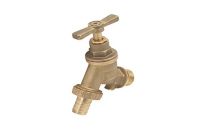
Outdoor tap types
An outdoor tap is a handy essential to have in any garden as it gives easy access to water without traipsing through the house. They are made from brass and rubber, so they’re rust-resistant and can stand up to the outside elements.
Garden taps are available with a screw handle or a lever that rotates 90 degrees. And they have a standard ¾ inch BSP connection to suit a standard hose connector.
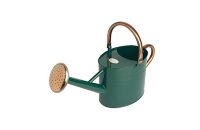
Watering can types
Watering cans are a great way to water gardens by hand. But they’re limited by their capacity, so they are best used for small gardens or plant pots on balconies. They’re also great for watering seedlings (using a fine spray rose).
Watering cans are available in plastic or steel and come in various sizes. The best size for your needs will depend on the area you’re watering, considering the number of times you may have to keep refilling the watering can to cover a large area. Small watering cans only have one handle. Large ones often have two – one to stabilise it while carrying it and another for tipping.
Most watering cans come with a rose, which is a head that attaches to the spout to gently sprinkle water. Roses can also be purchased separately.
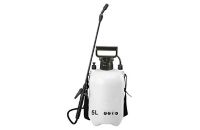
Garden sprayers and accessory types
Garden sprayers are ideal for watering seedlings and young plants as they emit a soft, fine spray of water. There are a few different types of garden sprayers available.
- A trigger sprayer: is operated using a trigger to produce the spray. They have a small capacity (usually 1L), so they are only suitable for small watering tasks.
- A handheld sprayer: is also operated using a trigger, but they’re pressurised to produce a stronger spray. They have a slightly larger capacity than trigger sprays (around 2L), so they are suited to small-medium sized watering tasks.
- A hand pump sprayer: has a pump on the top of the water bottle that must be pumped up and down by hand to build up pressure. The water is then released through a hose, connected to a lance and sprayed with force. Their capacity ranges from 5-7L, so they can handle medium-sized watering tasks.
- A backpack sprayer: is like a hand pump sprayer, except it can be worn like a backpack and the pump handle is on the side so it can be pushed up and down whilst being worn. They are designed for large watering tasks as they have a capacity between 12-20L.
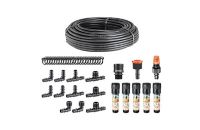
Water irrigation systems for gardens explained
A water irrigation system is a method of watering a garden using a network of hidden pipes, drip lines and water droppers connected to an outdoor tap. The system can be set up to water flower beds, plant containers, greenhouses and hanging baskets. And, used in conjunction with a timer, it can be set to automatically water on a schedule. The system is designed to dispense water gradually and get water directly to the roots of plants, therefore reducing the amount of water needed compared to other watering methods.
There are several water irrigation products available. You can buy complete kits with a set number of drip lines and water droppers, plus all the other components that make up the system. Or you can purchase the parts separately. So, you can either add extra pieces to a kit or design a system from scratch tailored to your needs.
We look at automatic garden watering systems and how they work in more detail in the next section below.
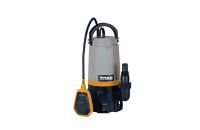
Water pump types
Water pumps are used for pumping water from an external source, such as a water butt, river or well. They are ideal to use where there’s no access to an outside tap.
There are several water pumps available. The most important thing to consider is their power and flow rate. Electric pumps have power measured in watts and can range from 100-750W. The higher the wattage, the more powerful the pump will be. Power will be a factor when considering the depth of the water it’s pumping from, the distance the water will be pumped and whether water will be pushed uphill. Flow rate is measured in litres per minute or gallons per hour. The higher the flow rate, the faster the water flow will be.
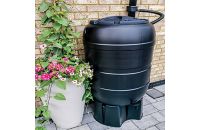
Water butts explained
A water butt is a great way to collect rainwater for the garden. It’s more environmentally friendly than using tap water, and it saves money on water bills. And another bonus is that plants prefer rainwater.
Water butts are best placed next to a garden structure, such as a shed. Then guttering around the structure is used to channel the rainwater into the water butt every time it rains. The water can then be used to fill watering cans. Or, you can add a pump that will enable you to link it to a garden irrigation system.
Water butts come in various shapes and sizes, from small or slim to large to suit any sized space.
How do Automatic Garden Watering Systems Work?
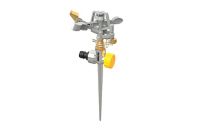
Automatic watering systems for garden plants offer a carefree way to water any garden. Once set up, they'll water a garden every day without the homeowner's interaction.
There are two types of systems. A drip irrigation system, which we’ll cover in more detail below, and an automatic garden watering sprinkler system.
For an automatic sprinkler system, you'll need a timer connected to an outside tap, a garden hose that connects to the timer and a sprinkler to connect to the hose. You can set up a single sprinkler or use a multi-tap connector to set up multiple sprinklers in different locations. Once set up, the timer is scheduled to automatically turn the sprinklers on at set times.
Automatic sprinkler system pros:
-
It can be used to water lawns, flowerbeds and vegetable patches
-
Takes the task of watering away from the user, saving them time
-
Setting the system up with a timer and schedule means the garden will stay watered in dry weather, and while the homeowner is away
-
Regular watering helps plants to grow healthier
-
Better plant growth helps to reduce weeds
Automatic sprinkler system cons:
-
It can’t be used to water greenhouses, hanging baskets or pots
-
There may be some disruption in the garden while the system is set up, such as digging channels in the lawn to install sprinklers
-
Sprinklers water from above, meaning more water will land on plant leaves rather than in the soil where it’s most needed
-
Watering isn’t targeted to specific plants, therefore, some areas will receive more water than others
-
High water usage, which could increase water bills when using mains fed water
How does drip irrigation work?
A drip irrigation system works in a similar way to a sprinkler system, except, instead of sprinkling water over a large area, the water is drip-fed slowly and gradually to individual plants.
The system is made up of many parts, and you can set up a system that's as simple or complex as needed. For example, you can start with a kit with all the necessary components to water a certain number of plants. Or you can buy components individually to set up a system tailored to the garden's needs.
Drip irrigation components include:
-
A garden tap, where the flow of water starts.
-
The water timer allows you to set a time and schedule to turn the system on and off.
-
A pressure reducer ensures only a low water pressure feeds through the system.
-
The main tube carries water through the whole system.
-
Main tube connectors are used to change the direction of the tubes or connect two or three tubes together to route water off to different places.
-
Feeding tubes are smaller, thin tubes that branch off the main tube to send water to individual plants.
-
Drippers, shrubblers and micro-sprinklers are the last components in the circuit that release the water. Drippers drip water directly into the soil near the root of plants and are adjustable so you can set them according to the plant and soil type. Shrubblers drip larger amounts of water, so they are suited to larger plants. And micro-sprinklers spray fine jets of water over a larger area.
-
Rain sensors are placed in an area away from the watering, where they'll be able to detect rain. They connect to the timer and turn the system off if it rains.
-
Support stakes can be used to raise the tubes and feeders off the ground.
-
End stoppers and hole plugs are used at the end of the main tube or to plug small holes along the length of the main tube.
Drip irrigation system pros:
-
It can be used on most areas of the garden, including flowerbeds, greenhouses, pots, hanging baskets and vegetable patches
-
Takes the task of watering away from the user, saving them time
-
Setting the system up with a timer and schedule means the garden will stay watered in dry weather, and while the homeowner is away
-
Irrigation delivers water slowly and straight to the roots, meaning less water is used overall compared to other watering methods, saving money on water bills
-
Controlled, slow watering produces healthier plants
-
Better plant growth helps to reduce weeds
-
Reduces plant diseases caused by overwatering
Drip irrigation system cons:
-
Large irrigation systems can be quite costly
-
Setting the system up will take some time, although the time saved in the long run will be worth it
-
Not suitable for watering lawns
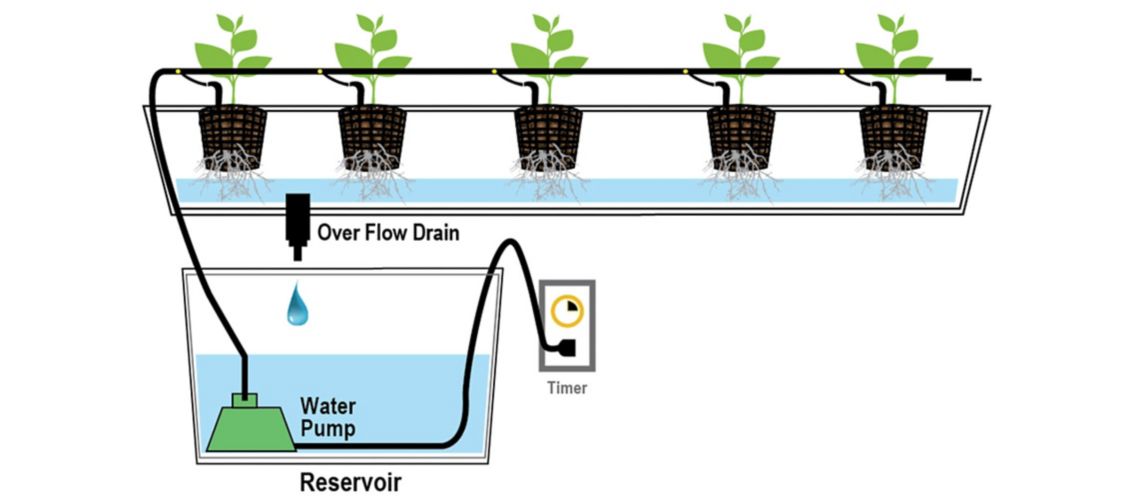
What to Consider When Buying Garden Watering Systems
We’ve covered the most important information about garden watering systems above, but here are a few more things to consider before you buy:
-
Watering frequency
There’s no one rule for watering because every plant has different needs. So, things to consider when watering a plant are:
- The plant’s size, type and growth stage: Large plants with plenty of leaves, fruit, or flowers will need more water than a small plant with fewer leaves and no fruit or flowers. And a mature shrub will need less water than a young shrub that’s still getting established.
- The soil type: Some soils, like clay, hold more water than other soils, like sandy soils. So, a plant in clay soil needs watering less frequently than a plant in sandy soil.
- Where the plant is growing: the soil in containers will dry out much quicker than the soil in a border. Also, plants with restricted roots (if they are close to a wall, for example) can’t spread out to find water, so they’ll need watering more often.
- The weather: Generally, plants need more water in the hot summer months than in winter. But humidity, rainfall and the wind are all factors too. Plants will need more frequent watering in hot, dry spells, even if there are light rain showers, as that won’t be enough to soak the ground. -
Flow rate of irrigation systems
The flow rate of irrigation systems refers to the amount of water that passes through a point in the system over a certain period. It’s usually measured in litres per minute. Feeder tubes, combined with the drippers, have a low flow rate. Plus, the drippers can be adjusted to reduce the flow rate further to suit the plant it is watering. Micro-sprinklers have a higher flow rate, so they are best used for plants that need more water. -
Garden tap installation
Fitting an outside tap is usually a straightforward job for a competent DIYer. Especially if you can fit it on the exterior wall of a kitchen where there’s easy access to the mains water supply running to the cold tap of the kitchen sink. The job may be more complex if there is no mains water supply, so this may be a job best left to a qualified plumber. -
Maintaining your garden hose
A garden hose should last for 5-10 years if it’s well maintained. There are a few things you can do to prolong its life and ensure it stays in good condition:
- Always drain the hose after use
- Coil the hose while it’s not in use
- Don’t leave it out in the sun, as exposure will degrade the material
- While in use, don’t drag the hose by the nozzle as this will weaken the connectors
- Store the hose and connectors in a garage or shed over the winter -
Irrigation installation
Garden water irrigation system installation is a job that can be carried out by a DIYer. Start with the garden watering system design. Plan out the system by drawing a scale plan of the garden, marking the location of the plants, pots and baskets you want to water first. Then plan where the main tube will go, the length you need and where any connectors need to go. Next, work out how many feeder tubes, drippers, shrubblers and micro-sprinklers you need. Setting the system up is then easy – simply follow your plan, adding each component one at a time. All tubes can be cut to length using a Stanley knife or sharp scissors. And you can use a tool, called a claber hole puncher to punch holes in the main tube to insert the feeding tubes.
